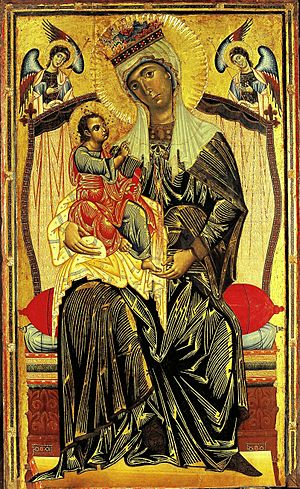Coppo di Marcovaldo facts for kids
Coppo di Marcovaldo (born around 1225 – died around 1276) was a painter from Florence. He was active in the mid-1200s. Coppo combined both Italian and Byzantine art styles. His unique way of painting greatly influenced many Italian artists who came after him.
Contents
Who Was Coppo di Marcovaldo?
Coppo di Marcovaldo is one of the most famous artists from the 1200s, a period called the Duecento. He was the first artist from Florence whose name and artworks are well-recorded.
One of the earliest mentions of Coppo is in a book called the Book of Montaperti. His name is listed there among Florentine soldiers. They were fighting in a war against Siena on September 4, 1260. This battle was known as the Battle of Montaperti.
Many historians believe that Coppo was taken prisoner by the Sienese during this war. They think he was held at the church of Servi. It was there, in 1261, that he painted his most famous work. This painting is called The Madonna del Bordone. He painted it for the Servites religious group.
Since he was likely a prisoner of war, people wonder why a Florentine artist was asked to create such an important Sienese painting. It is thought that Coppo must have already been very well-known. He was likely highly respected for Siena to ask him to paint for them so soon after the conflict.
The Madonna del Bordone Painting
The Madonna del Bordone is the only known painting by Coppo that still exists with his signature. It is believed that his signature and the date were visible on the painting around the year 1625.
The wooden panel for this painting is very large for its time. It measures about 220 by 125 centimeters, which is roughly 7 by 4 feet. The painting shows the Virgin Mary and baby Jesus. They are sitting on a tall throne with a high back. The Virgin Mary looks at the viewer. Her body is slightly turned to the left, and her head is bent towards Jesus. Coppo is widely believed to be the first artist to show the throne at an angle in paintings of the Virgin and Child.
The clothing in the painting is different from the usual Byzantine style. It seems to be from northern Europe. This might be the first time such clothing was shown in Tuscan paintings. Also, several new features appear for the first time in Tuscan art. These include the Child's bare arms and feet. There is also the Virgin's hand touching her child's right foot. The sash on the Child's clothes and the fabric He sits on are also new. All these details are linked to Christ's suffering (His Passion) and to the Virgin Mary. These were very important themes for the Servite patrons who ordered the painting.
The painting uses a lot of gilding, which means gold decoration. It also has a background made of gold leaf. Both of these features were typical of the Sienese art style. Coppo used a painting method called 'tecnica a velatura'. This means he first applied pure colors. Then, he covered them with tinted varnishes and glazes. This technique helped to make the figures look more three-dimensional.
Coppo's Art Style
It is clear that Coppo studied art while he was in Siena. His later works show a more balanced use of space. His figures have graceful poses and gestures. He also showed an interest in different textures. All these ideas came from Sienese painting.
Coppo was also strongly influenced by the Byzantine art style. This style focused on light, shadow, and volume. Artists used these elements together to make things look more real. The way Coppo painted clothes, like the bulky and stiffly folded fabric in the Madonna del Bordone, reminds us of old Romanesque sculptures.
Even though the Madonna del Bordone is Coppo's only surviving signed work, many other artworks are believed to be by him.
- 1261 – Madonna del Bordone in the Sta. Maria dei Servi at Siena.
- 1265 – Frescos in the chapel of St. James in the Cathedral of S. Zeno in Pistoia.
- 1265-68 – Madonna and Child in Sta. Maria dei Servi at Orvieto.
- 1265-70 – Last Judgment mosaic at the Baptistery of Florence Cathedral.
- 1274 – Crucifix in the Cathedral of Pistoia.
Other Pages to Explore
Images for kids
See also
 In Spanish: Coppo di Marcovaldo para niños
In Spanish: Coppo di Marcovaldo para niños




